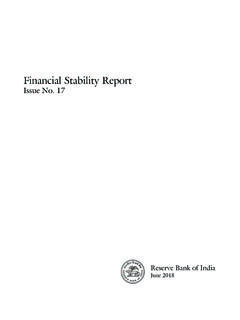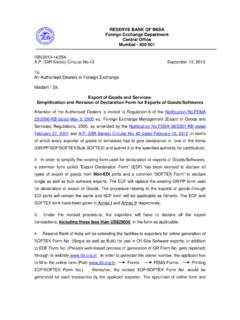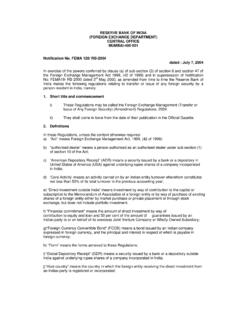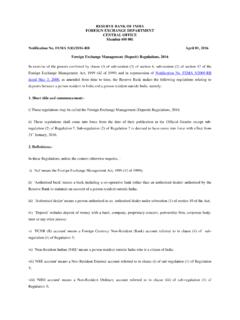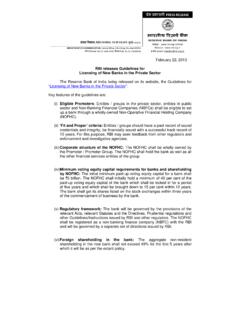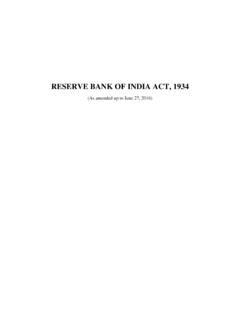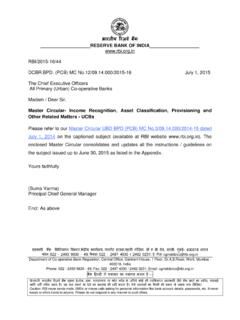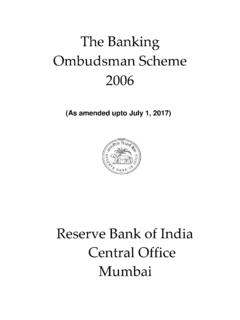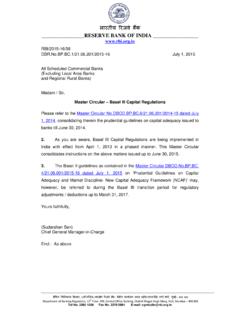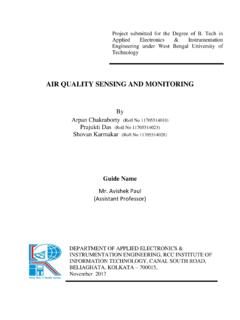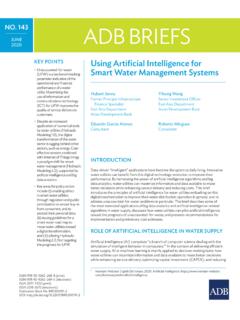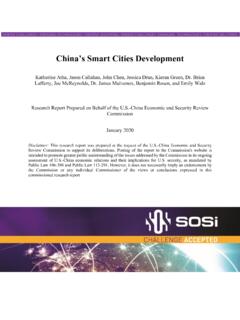Transcription of Report of the Working Group on Digital Lending including ...
1 Report of the Working Group on Digital Lending including Lending through Online Platforms and Mobile Apps Reserve Bank of India November 18, 2021 [1] [2] Acknowledgements The Working Group expresses its gratitude to the Governor, Reserve Bank of India, Shri Shaktikanta Das for entrusting the responsibility on the Group to comprehensively study all aspects of Digital Lending activities to enable an appropriate policy approach. The Group invited inputs and held virtual interactions with various stakeholders including financial institutions, government bodies, law enforcement agencies, academicians, and FinTech associations/ groups. The diverse interactions and different perspectives helped the Group in getting a holistic view of the nascent Digital Lending ecosystem. The Group would like to place on record its appreciation for all their valuable inputs, which have immensely helped in shaping this Report .
2 The Group would like to commend the rigorous work put in by the core secretarial team of the Department of Regulation, RBI, led by Shri Chandan Kumar, General Manager and consisting of Shri Anuj Sharma, AGM; Shri Lakshmana Koyya, Shri B G Gowtham Kumar Naik, and Shri Aditya Sood, Managers. The Group would also like to acknowledge and appreciate the contribution of the secretarial teams from Department of Supervision (Shri Susheel Raina, DGM; Shri A G Giridharan, DGM; Shri Nethaji B, DGM; Shri Varun Yadav, AGM; and Ms. Tricha Sharma, AGM) and Department of Payment and Settlement Systems (Shri Anuj Ranjan, GM and Shri Brijesh Baisakhiyar, AGM). The Group would also like to express gratitude to the Legal Department (Ms. Manisha Ranvah, ALA) and all the Regional Offices of Reserve Bank of India for the inputs provided. [3] Table of Contents Abbreviations.
3 4 Glossary .. 6 Executive Summary .. 10 Section 1: Introduction .. 14 Constitution of the Working Group .. 14 Foreground .. 15 Processes Followed .. 15 Broad Approach .. 16 Section 2: Digital Lending Landscape .. 19 Meaning: Digital Lending .. 19 Digital Lending Eco-System .. 20 Global Scene .. 22 Indian Scene .. 23 Trends and Future .. 30 Section 3: Regulatory Policy Approach to Digital Lending .. 31 Extant Indian Legal Regimes .. 31 Global Regulatory Practices .. 33 The Case for Regulatory/ Supervisory Review in India .. 36 Recommendations and Suggestions on Statutory-Regulatory Approach .. 42 Section 4: Technology Standards of Digital Lending .. 51 Factors Spurting Growth of Digital Lending in India .. 52 Digital Lending Lifecycle .. 55 Regulatory Perspectives of Digital Lending Technology .. 57 Recommendations/ Suggestions .. 63 Section 5: Financial Consumer Protection.
4 70 Extant Frameworks in India .. 70 Global Practices .. 74 Conduct Aspects of Digital Lending in India .. 76 Recommendations/ Suggestions .. 86 Gist of Recommendations in the Report .. 93 Gist of Suggestions/ Issues for Future Examination .. 98 Annex A - Synopsis: Inputs received from Stakeholders .. 101 Annex B - Details of Interfaces and List of Entities .. 128 Annex C - Extracts of Sample Survey data on Digital Lending .. 130 Annex D - List of Money Lending Laws in 134 Annex E - Global Practice in STCC Regulation .. 135 Annex F - Prescribed Format of Key Fact Statement/ Fact Sheet .. 139 Annex G - List of Statutes dealing with Usurious Interest Rates .. 140 Annex H - Rules to stop Debt Traps by CFPB, USA .. 148 Bibliography .. 149 [4] Abbreviations API Application Programming Interface AI Artificial Intelligence AML/ CFT Anti-Money Laundering/ Combating the Financing of Terrorism APR Annual Percentage Rate ASIC Australian Securities and Investments Commission BC Business Correspondent BIS Bank for International Settlements BNPL Buy Now Pay Later BR Act Banking Regulation Act, 1949 BSL Balance Sheet Lender CBIRC China Banking and Insurance Regulatory Commission CDD Customer Due Diligence CIC Credit Information Company CICRA Credit Information Companies (Regulation)
5 Act CoR Certificate of Registration DLA Digital Lending Application EDD Enhanced Due Diligence EMI Equated Monthly Instalment FCA Financial Conduct Authority FLDG First Loss Default Guarantee FPC Fair Practices Code FSB Financial Stability Board IBA Indian Banks' Association ICT Information and Communication Technology IRDAI Insurance Regulatory and Development Authority of India IT Act Information Technology Act, 2000 KFS Key Fact Statement KYC Know Your Customer LEA Law Enforcement Agency LSP Lending Service Provider MFI Microfinance Institution ML Machine Learning MI Market Intelligence MLC Micro Lending Company NBFC Non-Banking Financial Company NBFC-AA Non-Banking Financial Company-Account Aggregator NBFC-P2P Non-Banking Financial Company-Peer to Peer Lending Platform NCRB National Crime Records Bureau PBoC People's Bank of China PII Personal Identifiable Information RE Regulated Entity RMB Ren Min Bi RoC Registrar of Companies SACC Small Amount Credit Contract [5] SEBI Securities and Exchange Board of India SLCC State Level Coordination Committee SME Small and Medium Enterprise SRO Self-Regulatory Organisation STCC Short Term Consumer Credit UPI Unified Payments Interface WG Working Group [6] Glossary Application Programming Interface.
6 A set of rules and specifications followed by software programs to communicate with each other, forming an interface between different software programs that facilitates their interaction. Artificial Intelligence: Information technology (IT) systems that perform functions requiring human capabilities. AI can ask questions, discover and test hypotheses, and make decisions automatically based on advanced analytics operating on extensive data sets. Annual Percentage Rate: The annual rate that is charged for borrowing a loan and includes processing fees, penalties and all other charges that are applicable to the loan throughout its life. Balance Sheet Lending : Financial service involving extension of monetary loans, where the lender retains the loan and associated credit risk of the loan on its own balance sheet.
7 Balance Sheet Lenders: Lenders who undertake balance sheet Lending . Blackbox AI: A system for automated decision making often based on machine learning (deep learning) over big data mapping the users features into classes predicting their behavioral traits which cannot be interpreted/ explained by even those who design it. Buy Now Pay Later: A point of sale financial product where a borrower is allowed to purchase products on deferred payment basis and pays in a predetermined number of installments. Caveat Emptor: The principle that the buyer alone is responsible for checking the quality and suitability of goods before a purchase is made. Consumer Protection Risk: Derived from the definition of misconduct risk, consumer protection risk is the risk that the behaviour of a financial services entity, throughout the product life cycle, will cause undesired effects and impacts on customers.
8 Cooling-off Period: A period of time from the date of purchase of good or service from a distance ( , online, over phone or email order) within which the purchaser can change her/ his mind with return or cancellation of the purchase, as a part of Terms and Conditions of the purchase contract. Cyber Security: Protecting information, equipment, devices, computer, computer resource, communication device and information stored therein from unauthorized access, use, disclosure, disruption, modification, or destruction. [7] Digital Lending : A remote and automated Lending process, majorly by use of seamless Digital technologies in customer acquisition, credit assessment, loan approval, disbursement, recovery, and associated customer service. Digital Lending Apps: Mobile and web-based applications with user interface that facilitate borrowing by a financial consumer from a Digital lender.
9 Embedded Credit: The Lending services generated from the embedding of credit products into non-financial Digital platforms. FinTech (Financial Technology): A broad category of software applications and different Digital technologies deployed by the intermediaries that provide automated and improved financial services competing with traditional financial services. First Loss Default Guarantee: An arrangement whereby a third party compensates lenders if the borrower defaults. Key Fact Statement: A comprehension tool in the pre-contract stage of credit process consisting of a standardized form listing all the fees, charges and other key credit information that a financial consumer needs to make informed decision which promotes transparency and healthy competition. Glass Box Model: In a Glass Box model of AI, all input parameters and the algorithm used by the model to come to its conclusion are known imparting it better interpretability.
10 Explainable AI (X-AI) allows humans to understand and trust the output better. Lending Service Provider: Lending Service Provider is an agent of a balance sheet lender who carries out one or more of lender s functions in customer acquisition, underwriting support, pricing support, disbursement, servicing, monitoring , collection, liquidation of specific loan or loan portfolio for compensation from the balance sheet lender. (A balance sheet lender must have continuing ability to handle the above functions and the lender, not the LSP, must be able to demonstrate that it exercises day-to-day responsibility for the same, when LSPs are engaged.) Loan Flipping: The process of raising cash periodically through successive cash-out refinancings. Loan Stacking: The process of taking out multiple loans/ credit limits by a borrower from various sources within a short period in order to reach a financial goal, both legitimate and illegitimate.
